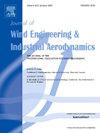污染源位置对均匀高层建筑群周围污染物扩散影响的风洞研究
IF 4.9
2区 工程技术
Q1 ENGINEERING, CIVIL
Journal of Wind Engineering and Industrial Aerodynamics
Pub Date : 2025-08-06
DOI:10.1016/j.jweia.2025.106194
引用次数: 0
摘要
本研究探讨了一组高层建筑(以下简称集群)周围污染物的扩散特性,重点研究了集群内部和周围不同源位置的影响。风洞实验包括同时测量示踪剂浓度和三分量速度。一些实验案例显示出明显的双峰羽状。采用双高斯分布拟合来描绘羽流边界。结果表明,污染源的位置对烟羽的形成有显著影响。具体来说,上游源(相对于集群)导致更均匀的污染物分布,而中心源(集群内)导致双峰浓度分布。在水平和垂直平面上对污染物通量的分析揭示了不同尾流区域的不同标量输运特征。在靠近星团的地方,梯度输运模型方法强调上游源经历了更大的平流输运,而星团内源表现出更强的湍流混合。本文章由计算机程序翻译,如有差异,请以英文原文为准。
Wind tunnel study of source location effects on pollutant dispersion around uniform tall building clusters
This study investigates the dispersion characteristics of pollutants around a group of tall buildings (hereafter a cluster), focusing on the effects of different source locations within and around the cluster. The wind tunnel experiments included simultaneous tracer concentration and three-component velocity measurements. Some of the experimental cases showed marked bimodal plume shapes. A bi-Gaussian distribution fitting was used to delineate the plume boundaries. Results demonstrate that the location of the pollutant source notably affects plume development. Specifically, upstream sources (relative to the cluster) lead to a more uniform pollutant distribution, whereas central sources (within the cluster) result in bimodal concentration profiles. Analysis of pollutant fluxes in both horizontal and vertical planes reveals distinct scalar transport characteristics across different wake regions. In proximity to the cluster, a gradient transport model approach highlighted that upstream sources experienced greater advective transport, whereas sources within the cluster exhibited stronger turbulent mixing.
求助全文
通过发布文献求助,成功后即可免费获取论文全文。
去求助
来源期刊
CiteScore
8.90
自引率
22.90%
发文量
306
审稿时长
4.4 months
期刊介绍:
The objective of the journal is to provide a means for the publication and interchange of information, on an international basis, on all those aspects of wind engineering that are included in the activities of the International Association for Wind Engineering http://www.iawe.org/. These are: social and economic impact of wind effects; wind characteristics and structure, local wind environments, wind loads and structural response, diffusion, pollutant dispersion and matter transport, wind effects on building heat loss and ventilation, wind effects on transport systems, aerodynamic aspects of wind energy generation, and codification of wind effects.
Papers on these subjects describing full-scale measurements, wind-tunnel simulation studies, computational or theoretical methods are published, as well as papers dealing with the development of techniques and apparatus for wind engineering experiments.

 求助内容:
求助内容: 应助结果提醒方式:
应助结果提醒方式:


